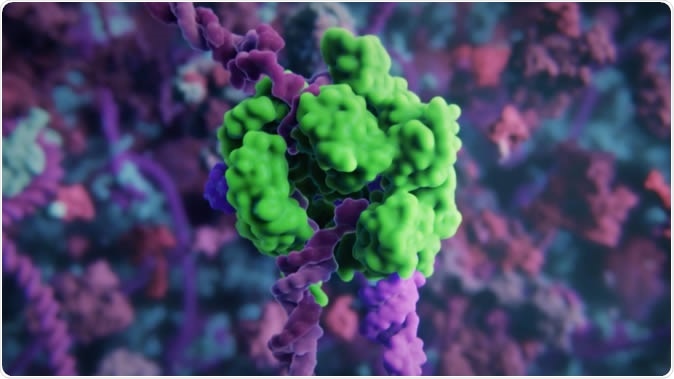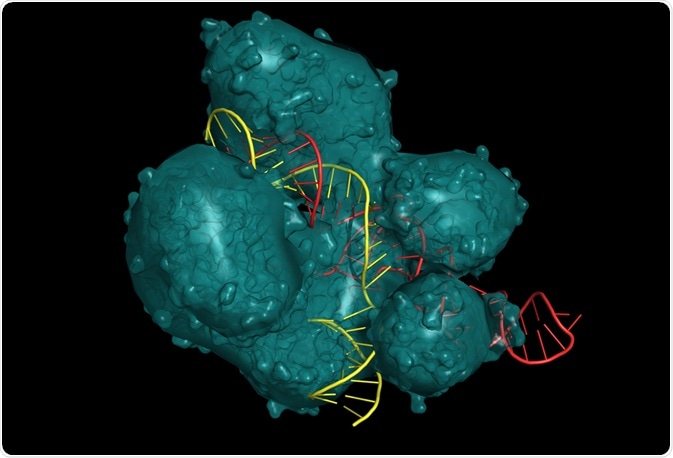
Nanoparticles used to deliver CRISPR gene editing tools into the cell
Researchers from Tufts University and the Chinese Academy of Sciences have developed a novel method to effectively deliver the CRISPR/Cas9 (clustered regularly interspaced short palindromic repeat (CRISPR) associated protein 9) gene editing tools into the liver for genetic studies.
The team used novel nanoparticles as carriers to do the courier’s job. Their study titled, “Fast and efficient CRISPR/Cas9 genome editing in vivo enabled by bioreducible lipid and messenger RNA nanoparticles”, was published in the latest issue of the journal Advanced Materials.

The large complex of gene editing molecules is difficult to deliver into cells from external an external application. Biodegradable lipid nanoparticles deliver mRNA coding for the gene editing molecules into the cell. Image Credit: From animation by Visual Science and Skoltech (https://visual-science.com/crispr )
The gene editing tool CRISPR/Cas9 has been one of the path breaking revolutions in gene editing and therapy using genetic modulation. There has been however always the challenge of how to get this mechanism into the cells effectively so that they could perform their appointed tasks. The team of researchers now have used biodegradable synthetic lipid nanoparticles that would help carry the editing tools for the genes into the cell. Now this tool would be used to change the genetic code with more than 90 percent effectiveness. The team of researchers add that these nanoparticles have been proven to be the most effective tool to carry the gene editing technology into the cell. This could be greatly beneficial for many patients who benefit from the therapeutic applications of CRISPR/Cas9 they add.
 ibreakstock | Shutterstock
ibreakstock | ShutterstockThe team writes that this new gene editing tool CRISPR/Cas9 has been a great boon for genetic research as well as providing gene therapy. It has been used successfully to understand the functions and molecular mechanisms of thousands of genes and their role in health and disease. Tweaking genes could be used to treat various disease and are being developed. One of the greatest hurdles in development of therapeutic applications for this gene editing tool is that it is a large molecular complex. It has a nuclease enzyme called the Cas9 that is utilized as scissors to cut through the strands of the genomic sequence. In addition the complex has a “single guide” RNA that has been engineered. It is called the sgRNA. This sgRNA scans the whole of the genetic code using the nuclease and finds the exact region that needs to be cleaved and edited. The whole complex thus is large and bulky and it is difficult to transport it into the living cell nucleus where it can function. There have been studies and attempts where researchers have used various delivery techniques including viruses, different types of nanoparticles, polymers etc. However none of these have provided a high efficiency of transfer so that the technique could be used for clinical therapy in patients.
The researchers for this study used lipid nanoparticles - BAMEA‐O16B. They used these nanoparticles to encapsulate the messenger RNA (mRNA) that could code for the Cas9. The contents of the nanoparticles release the mRNA as well as the sgRNA into the cell. The cell has its own protein making machinery that works to prepare the Cas9 from the mRNA template that is carried into the cell. Thus the Cas9 is ready for use within the cell prepared by the cell itself. Now the gene editing kit is ready, the team explains. The researchers add that these nanoparticles are made of synthetic lipids and contain disulfide bonds in the fatty chain. Once they enter the cell the disulphide bonds break open and now the nanoparticles get disassembled and the contents are released and distributed within the cell.
Qiaobing Xu, co-corresponding author of the study and associate professor of biomedical engineering at Tufts University explained, “We are just starting to see human clinical trials for CRISPR therapies. There are many diseases that have long been intractable for which CRISPR therapies could offer new hope - for example sickle cell disease, Duchenne muscular dystrophy, Huntington's disease, and even many cancers. Our hope is that this advance will take us another step toward making CRISPR an effective and practical approach to treatment.” The study first author was Ji Liu, graduate student from Chinese Academy of Sciences, Institute of Chemistry.
For this study the team of researchers used lab mice and utilized these nanoparticle carriers to tweak and reduce the activity of a gene in the mice coding for the PCSK9. When this gene is lowered, it reduces LDL cholesterol and thus reduce the risk of cardiovascular disease. Results showed that superior efficacy of the gene editing tool when the lipid nanoparticles were used.
Ming Wang, co-corresponding author of the study and professor at the Chinese Academy of Sciences, Beijing National Laboratory for Molecular Science, explained, “The lipid nanoparticles are one of the most efficient CRISPR/Cas9 carriers we have seen. We can actually knock down PCSK9 expression in mice with 80 percent efficiency in the liver, suggesting a real promise for therapeutic applications.”
Authors of the study concluded, “The leading lipid nanoparticle, BAMEA‐O16B, represents one of the most efficient CRISPR/Cas9 delivery nanocarriers reported so far, and it can broaden the therapeutic promise of mRNA and CRISPR/Cas9 technique further.”
The study was funded by National Key Research and Development Program of China and the National Science Foundation of China along with National Institutes of Health.
Journal reference:
Liu, J., Chang, J., Jiang, Y., Meng, X., Sun, T., Mao, L., Xu, Q., Wang, M., Fast and Efficient CRISPR/Cas9 Genome Editing In Vivo Enabled by Bioreducible Lipid and Messenger RNA Nanoparticles. Adv. Mater. 2019, 1902575. https://doi.org/10.1002/adma.201902575, https://onlinelibrary.wiley.com/doi/abs/10.1002/adma.201902575






















.jpg)












No hay comentarios:
Publicar un comentario